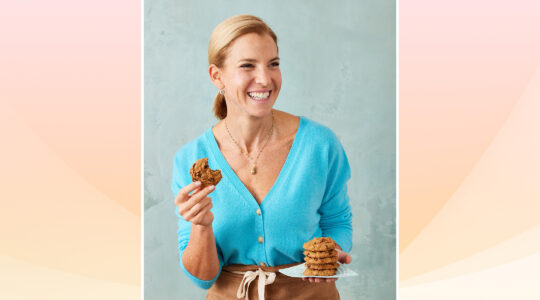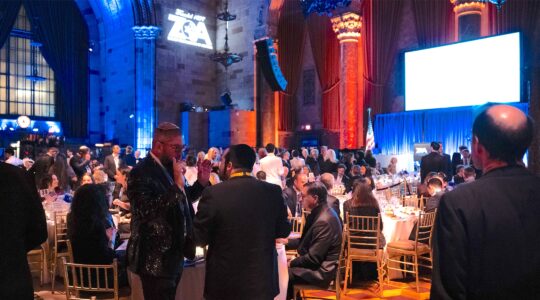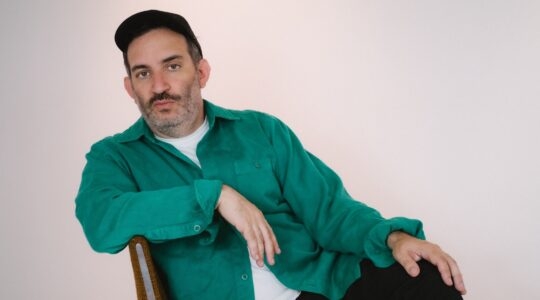When Gabi Levin isn’t teaching student science modules or instructing pole-dancing classes, she’s brainstorming what to prepare for her communal Friday-night Shabbat meal.
“Fitting Judaism into my life post-college was a big challenge,” said the 24-year-old dancer, “mad scientist” and aspiring actress. Though her day jobs are far from the norm (pole-dancing still raises eyebrows, she says), Levin, a Reform Jew, feels passionately about creating a non-judgmental space for young Jews. “When there’s no campus Hillel and you’re far away from home, where do you go for a Shabbat meal?” she said.
Enter Moishe House, one of the fastest-growing outreach initiative for Jews in their 20s. Founded in 2006 to help young Jews create communities, the movement has been rapidly expanding — last year, 16 new houses opened in cities worldwide, including Paris, Prague and Cape Town. The global network includes 75 houses in 17 countries, up from 29 outposts in 2010.
The movement initially struggled to gain a foothold in New York, given the city’s plethora of hip cultural programming for young unaffiliated Jews in their 20s from such groups as 92YTribeca, Brooklyn Jews, Heeb Magazine and the Soho Synagogue.
But they appear to have found their niche. In the past three months, three new Moishe Houses have opened in New York City, adding to the four houses already here since 2012. New York now has the most houses of any city worldwide with locations in Murray Hill, Park Slope, the West Village, the Upper East Side, the Upper West Side and Williamsburg.
“We’re like the new Chabad,” joked Levin, referring to the widespread Chasidic movement known for outreach. Levin is one of three residents manning the newly opened Moishe House in the West Village. But, unlike many Chabad Moishe House is exclusively for millennials — “we’re for young people who don’t just want to sing Hebrew prayers the whole time,” she said.
As synagogues across the U.S. struggle to keep up engagement among young adults, innovative models are in high demand. A recent study by UJA-Federation of New York on voluntary dues in synagogues indicated that younger adults seem less interested in affiliating with Jewish institutions than older age groups.
Moishe House provides an alternative. The model is simple: residents, young Jewish professionals, are responsible for organizing events for other Jewish 20-somethings in exchange for subsidized rent. The level of subsidy depends on how many events residents agree to host; houses that host seven or more programs each month receive a rent subsidy of 75 percent of their total rent or a monthly payment of between $2,750 and $3,000, depending on their location. In New York, all seven Moishe Houses host the maximum of seven or more events per month.
In New York, most of the “houses” are spacious apartments. The Upper East Side Moishe House is a three-story apartment, where each resident has her own room. The cheerful living room is equipped with multiple couches, a flat-screen TV, funky lamps and ample dining space. The space is welcoming and deeply personalized, with artwork and photographs decorating the walls and candles and a vase of tulips in the living room.
“This place became home for us quickly,” said Ellie Epstein, 23, one of the Upper East Side residents.
Moishe House’s CEO, David Cygielman, co-founded the organization in Oakland, Calif., in 2006 with artist and philanthropist Morris Bear Squire (whose Yiddish name is Moishe). Initially fully funded by Squire’s Forest Foundation, it became an independent nonprofit in 2009.
Fueled by word-of-mouth, social media and the support of some of America’s largest Jewish foundations, including the Paul E. Singer Foundation, the pluralistic Moishe House has grown rapidly since its Oakland launch. It is partnering with UJA-Federation of New York to expand in New York.
Support the New York Jewish Week
Our nonprofit newsroom depends on readers like you. Make a donation now to support independent Jewish journalism in New York.
“I definitely think young Jews are coming here as an alternative to synagogue or JCCs,” said Orly Michaeli, a resident at the Upper West Side Moishe House that opened in late 2014. Michaeli is the only woman in the house — her three Moishe House roommates are men. “The four of us are so different that people are able to find their niche,” she said. She added that the house does also host prayer services. “When we have a minyan here, people make it their own,” she said.
Though Michaeli defines herself as “traditional,” her housemates range in terms of affiliation, including one roommate who is an Orthodox rabbinical student. “There are no labels when you come here, just people,” she said.
Still, some have expressed skepticism towards the movement’s strong focus on social engagement, at the expense of religious content.
“Getting people to hang out at bar together is nice, but it’s not all that Jewish,” said one event attendee who asked for anonymity. She mentioned the West Village Moishe House’s “Torah on Tap,” a monthly event to discuss the weekly Torah portion while out for drinks. “It’s nice, but something is sacrificed.” She said the event felt more like an excuse to go to bar than an opportunity to engage with Judaism.
Rebecca Bar, the senior regional director for Moishe House on the East Coast and Midwest, said the concern has been addressed by increasing the number of Jewish-content related events houses must host. Though she describes the movement as “more of a cultural center,” she said Jewish learning programs do happen. Residents of the houses are responsible for supplying their own content.
On the Upper East Side, three Modern Orthodox women run the newly opened Moishe House, an anomaly for the pluralistic organization. All three attended Jewish day schools through high school, and unlike several of the other houses, the Upper East Side residence keeps a strict level of kashrut.
“There’s a lot of diversity among the New York houses,” said Jessica Levenson, 24, of the Upper East Side house. She explained how the nature of each Moishe House is deeply affected by its constituents. “We’re not recruiting people for something, we’re not here to do kiruv,” she said, using the Hebrew word for outreach. “We’re just giving people an easy way to connect to their Judaism, and with others.”
The absence of singular authority is particularly attractive to young Jews, said Hannah Friedman, 23, another resident in the Upper East Side house.
“We’re for the people, by the people,” said Friedman, a kindergarten teacher. “People keep coming back because everyone can be involved, and everyone can be themselves. That’s what young Jews want.”
Identifying what young Jews want remains the priority for Bar.
“When you empower young people, they will get stuff done,” she said, describing opening in New York City as a “splash.” “Residents are creating Jewish communities from the bottom up, and that’s why people stay.”
At the West Village House, the most popular events are those that integrate popular culture with Judaism, Levin said. She said the house’s Halloween Shabbat, which included a Twizzler challah and Laffy Taffy matzah balls, was the house’s most popular event so far. While an average Shabbat dinner attracts about 20 guests, over 40 showed up the holiday-themed evening.
Support the New York Jewish Week
Our nonprofit newsroom depends on readers like you. Make a donation now to support independent Jewish journalism in New York.
“When we do things that bridge the gap between people’s social interests and Judaism, people come,” she said. “At the end of the day, young Jews feel strongly Jewish, but they also feel strongly American. We’re in the same place. We get it.”
The New York Jewish Week brings you the stories behind the headlines, keeping you connected to Jewish life in New York. Help sustain the reporting you trust by donating today.




